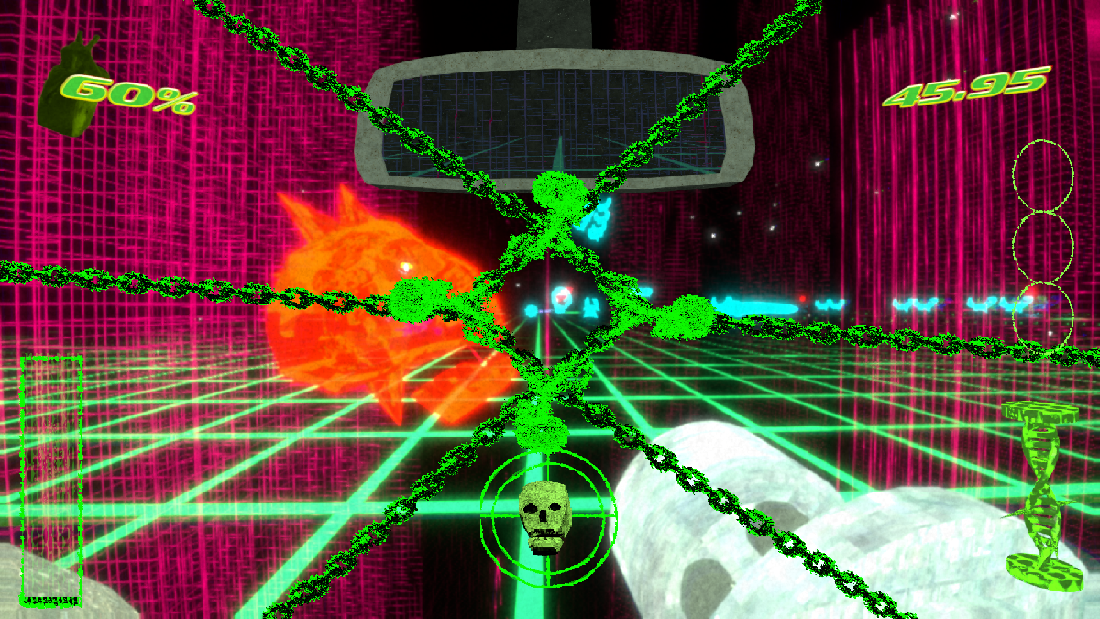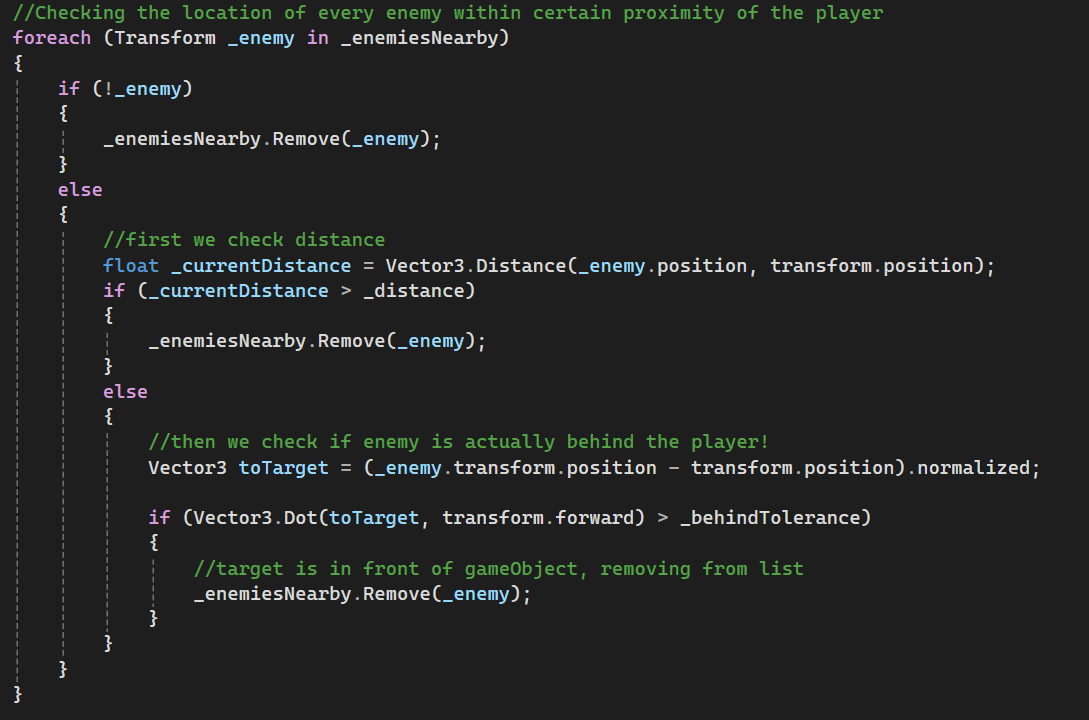Visage Green
Roles and Responsibilities:
Designed and iterated on core gameplay systems such as player movement, gunfire combat, enemy pathfinding
Assisted in development and maintenance of an expanding codebase in C#
Implemented a variety of game management systems including enemy spawns and proximity trackers
Modeled, rigged, and animated all 3D art assets
Created, implemented and animated all 2D art assets including HUD elements and menu icons
Game Overview:
Visage Green is a fast-paced arena shooter where players control a hulking mech interface and attempt to survive as long as possible while annihilating hordes of demonic digital entities.
Gameplay is endless, with the goal being to survive as long as possible while fighting off waves of oncoming enemies. Upon death, players are scored according to their time spent alive and encouraged to reach new high scores.
Combat is intentionally hectic, as players are pushed to use all of the tools at their disposal, including a speedy automatic rifle, heavy shotgun, charged jumps, dash-kicks, and even a hyper meter that launches devastating bombs upon activation.
Development Process:
Visage Green was initially created for a 7-day game jam, as I and a peer wanted to challenge ourselves and see what we could create within a single rushed week of development. The main inspirations for Visage Green were the gameplay loop of Devil Daggers and the visual noise of Cruelty Squad - we wanted to create a game that was messy, challenging, mean, and endlessly replayable. The short nature of the game jam encouraged us to focus on a small handful of interesting systems and interactive variables rather than large amounts of discrete content. Thus, a difficult score-based arena shooter felt like the perfect fit - we could experiement with dynamic movement systems (dashing and ground-pounding), and demanding player restrictions (guns that overheat, strict combo requirements, and long ability cooldowns) in an intimate environment.
After the end of the week’s development cycle, we were wildly happy with our progress, and determined to continue working on the game for the next several months as an after-hours side project. It was during this phase that the game’s sense of identity could truly flourish, as we nailed down a unique art style and refined the core gameplay loop to exhibit a white-knuckle sense of dire stakes.
Enemy Proximity Tracker:
One challenge that we faced during development was arena legibility. WIth dozens of enemies all hunting the player at the same time, we found that testers were often being constantly attacked by offscreen enemies, resulting in a frustrating sense of unfairness. While we wanted Visage Green to be satisfyingly difficult, this was a step too far into cruelty. I created several solutions to this issue, and found that together, they were able to maintain a sense of fair challenge. First, I created a rearview mirror that hangs from the top of the viewport, allowing players to see anything directly behind them. Along with this, I created a system that constantly checks for the number of enemies both near the player and out of their sight, and edits their pathfinding intelligence to act less aggressively when not in view. And finally, I created a UI/sound element on the bottom of the screen that alerts the player of nearby enemies with a ridiculously pulsating neon-green skull. These additions not only made the game’s challenge feel more reasonable, but also contributed to a unique aesthetic identity of over-the-top cyber absurdism.
Art Design:
The first aesehtic decision for the game was made for efficiency’s sake, as creating an environment out of glowing grids was a convenient way to avoid the need for texturing during such a rushed devleopment window, and the rest of the “cyber-trash” visual identity was extrapolated from that decision. I strove for visual identity that felt equal parts absurd, striking, and overwhelming, and accomplished this through a mixed-media approach to asset creation that included animated 3D models, rotoscoped sprites, and art-bashed Photoscop collages. All models were created, rigged, and animated by myself.
Player Movement Implementation:
The primary inspiration behind the movement mechanics for Visage Green were the Armored Core games. We wanted player navigation to be elastic, bouncy, and aggressive, with a wide range of movement. I created a system in which the player is able to quickly move in any direction with a burst of speed, while always remaining beholden to current velocty - turning on a dime is hard when you’re a hulking mech traveling at dozens of miles per hour! Featured below is a snippet of C# code for player movement, as well as that script in action during an early test phase of the game. The script takes the player’s desired motions and compares them to the available total velocity after considering current movement speed, grounded status, and acceleration, resulting in a movement system that feels both agile and heavy.
This project also proved a great opportunity to flex my tech art skills and become more comfortable with Unity’s shader graph. Featured below is a custom trail shader utilized with several materials in-game, including player projectiles and the gibbed remains of exploded enemies. The shader takes a texture slot and adds a shifting, disentegrating tail that trails behind objects as they sail through the air. The shader adds minimal performance stress as well, as it is essentially just multiple panning alphas multiplied by a color gradient.
Wrapping Up:
If I were to boil the game’s driving design philosophy into a few words, I would say: presure and balance. Wolves are chasing from the floor, cicadas are populating the sky like a dark cloud, snakes are searching for the right moment to pounce, and scorpions are launching projctiles that whip through the air. The player constantly needs to be moving for their own safety, and yet charging into the air requires that they stay still for a whole second at a time. Dashes are on a strict cooldown that must be kept in mind, and yet building the hyper meter (which is required to enter turret mode) can only be done through slaughtering enemies at a vicious pace. We wanted the game to feel breathless, as though you can’t yank your vision from the screen for even a second during a round, your heart pounding and forehead collecting perspiration as you attempt to survive for just one more second.
This project was an excellent chance to get my hands on nearly every aspect of development, from gameplay design to programming to 3D art. Possessing scripting and technical art capabilities are immensely useful to my work as a designer, as I do not have to wait for my ideas or edits to be implemented by another team member - rather, I can hop right in the engine to create the assets and write the logic I need.
Visage Green can be played here - see how long you can endure against the terrible onslaught of digital demonic entities!
Platform: PC, Mac
Engine: Unity
Production Time: 10 weeks
Size of Team: 2
Roles: Gameplay Designer, Engineer, 3D Artist
Link to Playable Game: Visage Green Itch.io





